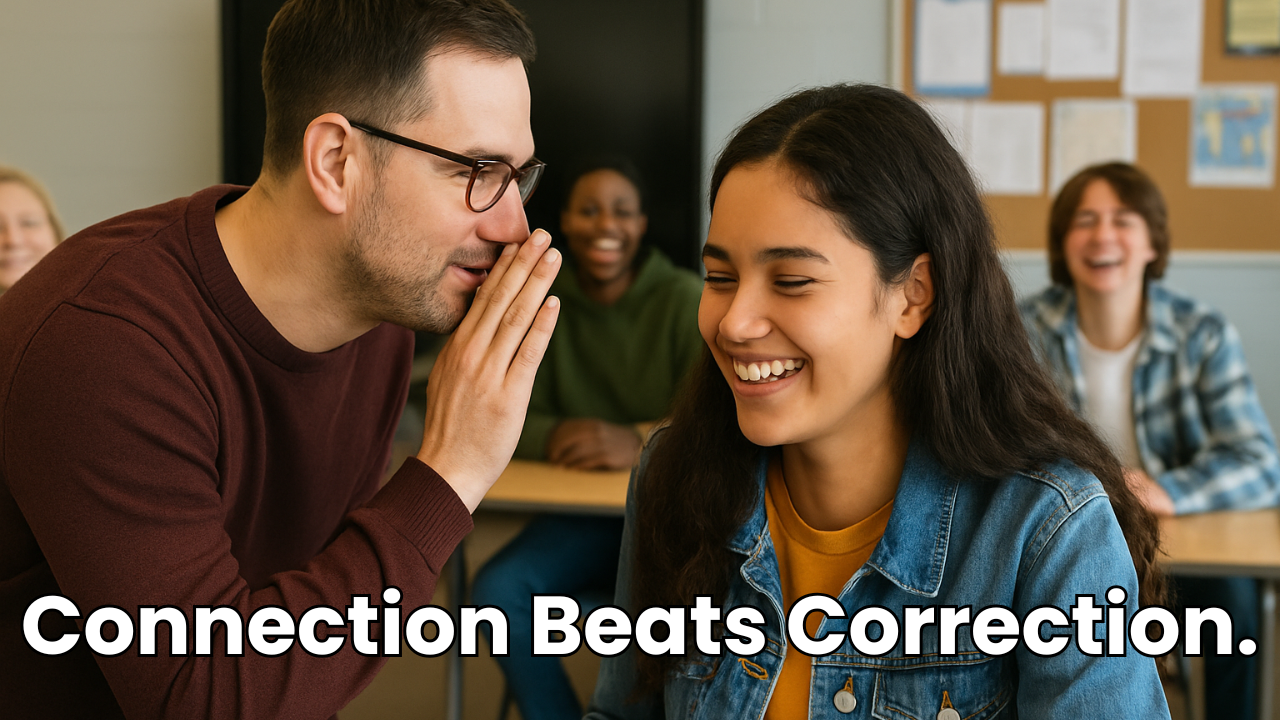
Do you struggle with asking questions?
Do your questions get repetitive and boring?
Do you ask too many or too few questions?
If any of that sounds like you, you’re not alone.
Asking questions to get the language in students’ heads is not easy.
It’s an art form.
Read on to find out how you can master this art form and ask questions like the best of them!
The Basics
There are two things to consider when asking questions to maximize language input: scaffolding and differentiation.
You want to scaffold the questions so that you meet the students where they are and then slowly increase the difficulty of the question as their comprehension and language proficiency grow.
Here’s the basic hierarchy of questioning:
- yes/no questions - these are the simplest type of questions
- either/or questions - these are also pretty simple, but a step up from yes/no questions
- simple question-word questions - who, what, where, when—these usually can be answered with a single word
- complex question-word questions - how and why—these usually require a bit more language to answer
Along with scaffolding, you have to take differentiation into account. This means asking the right question to the right student at the right time.
Generally speaking, you’ll ask yes/no or either/or questions to your slower processors. These are your students who are struggling with the language but still trying to get it.
You’ll ask your simple question-word questions to your average processors. These are usually the bulk of your class. They don’t struggle with language comprehension but may have difficulty expressing themselves in the language.
How and why questions are reserved for your top processors. These are those students who not only understand the language, they are able to express themselves at some level. They are usually quick to answer questions and often volunteer input. They need to be challenged in the language and be able “show off” their language abilities to feel valued as students. This is not a negative thing, but it’s their “love language” in class.
Now that you know what types of questions to ask and who to ask them to, you have a basis for asking questions.
How to Ask Questions
So you know the types of questions and who to ask them to, but what do you ask questions about?
The whole reason we ask questions is so that students hear the patterns of the language enough times that it gets into the “instinct” part of their brain.
How many times does a student need to hear a pattern before that happens? I don’t think anyone knows for sure. For some patterns and some students, only a few times may do the job. But for other students or with more complex patterns it may take hundreds of exposures or more.
Our goal then is to work the sentence as much as possible before moving on to the next sentence and the easiest way to do that is with questions.
Every sentence generally has three parts: the subject, the verb, and the object/predicate.
When we ask questions we need to focus on each part separately and that allows us to repeat the basics of the sentence dozens of times and over time (not just one class period or over a single week), these patterns will start to become second nature to students.
It doesn’t matter which part of the sentence you start asking questions about, so just pick one.
You know the hierarchy of questions, but you don’t want to always ask questions in that order or students will be able to predict the answers without really listening to the questions. So randomly ask a question to get the ball rolling.
You’ll start by asking questions to the whole class before beginning to ask individual students questions.
But remember, when you ask a student a question, be sure to ask them the right question. That means depending on the type of language processor they are, you will ask them a yes/no or either/or question, a simple question-word question, or a how or why question.
It’s important that you are confident the student can answer the question you’re asking of them or DON’T ASK IT!
The last thing you want to do is to embarrass your student.
You’re going to as many different questions as you can about each part of the sentence before moving on to the next part of the sentence. It might look something like this:
A girl wanted a dog.
- What did the girl want?
- Did the girl want a cat?
- Did the girl want a bird?
- Did the girl want a cat or a dog?
- Did a girl or a boy want a dog?
- Did a boy want a dog?
- Did a girl want a dog?
- Who wanted a dog?
- Did a girl have or want a dog?
- Did a girl have a dog?
- Did a girl want a dog?
- Did a girl eat a dog?
- What did the girl do?
As you can see from the example, we didn’t deviate or add anything to the sentence, but we got 13 separate repetitions of the sentence by just asking questions.
But we can easily DOUBLE that number.
How?
I’m glad you asked!
After you ask the question and students answer the questions REPEAT THE ANSWER BACK! That will easily double the repetitions. Let’s take a look:
A girl wanted a dog.
- What did the girl want? — The girl wanted a dog.
- Did the girl want a cat? —No, the girl didn’t want a cat. The girl wanted a dog.
- Did the girl want a bird?—No, the girl didn’t want a bird. She wanted a dog.
- Did the girl want a cat or a dog?—The girl wanted a dog.
- Did a girl or a boy want a dog?—A girl wanted a dog.
- Did a boy want a dog?—No, a boy didn’t want a dog. A girl wanted a dog.
- Did a girl want a dog?—Yes, the girl wanted a dog.
- Who wanted a dog?—A girl wanted a dog.
- Did a girl have or want a dog?—The girl wanted a dog.
- Did a girl have a dog?—No, the girl didn’t have a dog. She wanted a dog.
- Did a girl want a dog?—Yes, a girl wanted a dog.
- Did a girl eat a dog?—No, a girl didn’t eat a dog. She wanted a dog.
- What did the girl do?—The girl wanted a dog.
Do you see how that works?
But still, with all of those questions, we’ve simply stuck to the original, basic sentence. But by asking questions about each part of the sentence, we were able to get dozens of repetitions.
But there’s more…
Adding Details
To get even more repetitions— remember repetitions means more opportunities to get the patterns of language into students’ heads—we can slowly add details to the original sentence and then ask even more questions about the new detail.
So, again, if we started with…
A girl wanted a dog.
- What kind of dog did the girl want?—That’s right! She wanted a big dog!
- Did she want a small dog?—No, she didn’t want a small dog. She wanted a big dog.
- Did she want a big dog?—Yes, she wanted a big dog.
- Did she want or have a big dog?—She wanted a big dog.
- Did she have a big dog?—No, she didn’t have a big dog. She wanted a big dog.
- Did she want a big or a small dog?—She wanted a big dog.
- Who wanted a big dog?—A girl wanted a big dog.
- Did the girl want a big cat?—No, the girl didn’t want a big cat. She wanted a big dog.
You get the idea. You could ask questions all day by just adding another detail and another, and another.
Generally, I like to ask my questions about the basic sentence, and then add up to 3 details each, asking my round of questions in between.
Slow Processors are the KEY!
Although you will be asking questions to the class as a whole and to individual students, the questions you ask and the answers you get from the slow processors are the key.
Why, you ask?
Because if the slow processors can answer the questions correctly, then you can reasonably assume that the rest of the class understood.
But if you ask an average or top processor, just because they know the answer doesn’t mean any of the lower processors do.
So, yes, I want to ask questions to a variety of students, but I’m really keeping my ear out for the slower processors because they help me to do my job better!
If a slower processor is struggling, that means I need to work that sentence even more.
But if they get it, I can move on to the next question or the next sentence.
Pro Tips
Circle NEW structures. With lower levels, you need to circle most sentences. With upper levels, circle only new or difficult structures.
Teach to the EYES. Teach STUDENTS, not curriculum. Look in individual student’s eyes when teaching. Hold students accountable. Always check for UNDERSTANDING.
Translate. Translate only what students don’t know. Write all new words on the board. Ask students to translate to check for understanding. Don’t translate everything.
So now you have a good foundation upon which to build your question-asking skills.
If you have any questions, please don’t hesitate to write them in the comments below!
Plus, don’t forget to download our Asking-Questions Guide!
Happy Comprehensible Input!



